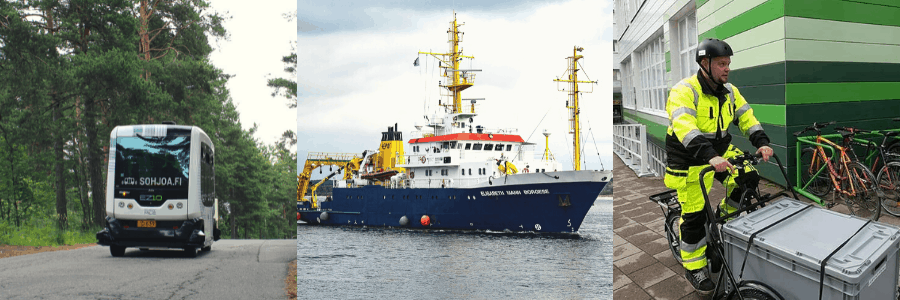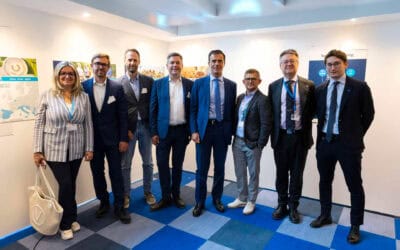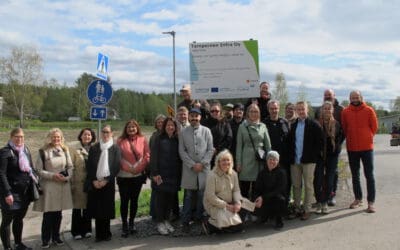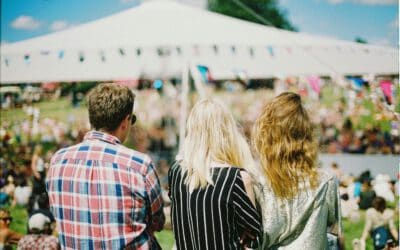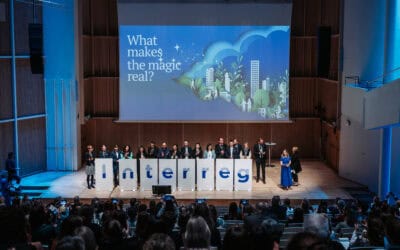In line with the EU’s climate neutrality target, our Programme supported several initiatives tackling the diverse challenges faced by the Baltic Sea region’s transport sector. We united our efforts to make our region more accessible, better connected and less polluted, ultimately improving the overall mobility experience in the area while protecting the environment. Read how Interreg Go LNG, BSR electric and Sohjoa Baltic have contributed to green mobility and innovation in transport sectors in the region.
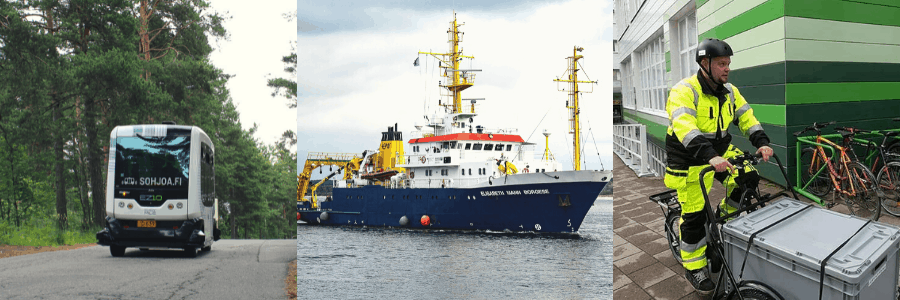
© on the left: Milla Hakkarainen, in the middle: Pixabay, on the right: Turku University of Applied Sciences/BSR electric
The environmental challenges posed by transport
Transport is one of the major sources of pollution in the Baltic Sea region, and in the whole EU, reducing substantially the air quality in our cities. Air pollutants like nitrogen dioxide (NO2) and particulate matter (PM) threaten the ecosystem as well as human health. In 2016, road transport accounted for almost 72% of total greenhouse gas emissions from transport in the EU, while maritime transport was responsible for 13.4% of the emissions; according to the European Environment Agency (EEA).
To reduce the negative effects of transport’s emissions, the EU developed a strategy and action plan guiding transport transformation towards ‘net-zero’ greenhouse gas emissions across the EU by 2050. The idea is to make all transport modes more sustainable thanks to the use of green alternatives (e.g. green fuels and e-vehicles) both at sea and on land.
What is the Interreg Baltic Sea Region doing to enhance green mobility?
The Programme is aligning to the EU’s targets for the reduction of transport emissions by tackling the challenges that this green transformation poses to the countries in the Baltic Sea region. In particular, as many as 34 projects relate to sustainable transport. These are mainly focused on enhancing clean shipping or environmentally friendly transport systems in urban areas. Among those, a good illustration of our Programme’s work on different aspects of green mobility are Go LNG, BSR electric and Sohjoa Baltic.
A greener alternative fuel for shipping
Liquefied natural gas (LNG) is a natural gas fuel, predominantly methane, that is cooled down to very low temperatures at which it becomes liquid. LNG emits no sulphur, no nitrogen and less CO2 than heavy oil and ship diesel and, due to its liquid form, it can be easily stored or transported. Its properties make it an interesting and greener alternative fuel for the shipping industry.
As pointed out by Andrius Sutnikas, project manager of Go LNG, “LNG is a cleaner energy source that opens up opportunities for sustainable fuels in terms of technology and infrastructure. For instance, if you want to shift from LNG to renewable liquefied biogas (LBG), you can do it easily by using the exact same engines for ships.” So, by developing LNG infrastructure in the Baltic sea region you can pave the way to other greener fuels such as liquefied biogas.
Project partners identified the necessary conditions and the right approach for a successful use of LNG in the Baltic Sea region. They built a competence centre uniting research, educational and consulting institutions to spread knowledge on how to develop LNG. “We trained over 1000 people in the region; from seamen, drivers, to generally those working in the transportation and liquefaction sectors. We built a critical mass of knowledge on LNG; which is essential because there can’t be any infrastructure development if people don’t understand why it’s needed.”
Besides that, Go LNG established the first macro-regional business cluster in Europe for LNG. “We brought over 300 companies together, facilitated a lot of business-to-business (B2B) activities, conferences and networking events to consolidate an LNG value chain in the region.” In practice, they connected and promoted local stakeholders offering and using LNG services, knowledge and technologies.
The network is maintained beyond the project’s lifetime. “Now, we try to promote decarbonisation by using our LNG network, the LNG capacity and knowledge we have.”
E-mobility to cut on emissions in the cities of the region
“Electric mobility can contribute to the transitioning of transport systems toward low carbon transportation by reducing emissions and ultimately enhancing the air quality and well-being of the population in urban areas, where air pollution is quite substantial,” explained Franziska Wolf, project manager of BSR electric.
Project partners analysed the current use of e-mobility in the Baltic Sea region and ran seven pilot activities in Høje Taastrup (Denmark), in Helsinki and Turku (Finland), Hamburg and Rostock (Germany), Tartu (Estonia), Gdansk (Poland) and Riga (Latvia). “We focused on e-bikes, on e-scooters, on e-buses and e-ferries. So, different fields where electric mobility can play a role in inducing change from within by showing that these e-mobilities solutions actually work.”
A good example is the Helsinki pilot. The project encouraged Finnish families to replace their second cars, which are quite popular in metropolitan areas in the country, with e-bikes. During several campaigns carried out between 2018 and 2020, Finnish families had a chance to use e-bikes to see if they suited their needs. “The campaign was quite a success, beyond what was originally foreseen. Many families realised that this e-mobility solution worked so well for them that they didn’t actually need a car at all.”
Based on the pilots, the project provided decision makers, municipalities, cities, transport providers and companies with specific recommendations. “Now, they will build upon the collected data, practical experiences and collaborator network, and use this in future plans and strategies.”
A ride onboard of autonomous & driverless minibuses
Making public transport more accessible and attractive is the right way to convince people to shift towards greener mobility solutions and thus to decrease traffic emissions in our cities.
Our project Sohjoa Baltic piloted environmentally friendly and smart automated public transport in the Baltic Sea region. It helped people to consider their daily choices offering the alternative solution of a driverless bus especially for the for the first and last mile of the journey (e.g for those who need an additional connection between a station and the final destination).
In practice, Sohjoa Baltic tested autonomous, electric shuttle busses in the streets of Helsinki (Finland), Tallinn (Estonia), Kongsberg (Norway), Gdansk (Poland) and the very first robot bus pilots took place in two cities in the Zemgale region (Latvia). The automated electric shuttles drove along their routes scanning the surroundings and slowing down or stopping in case of obstacles along the way. During the pilots there was always an operator on board to be sure that everything run smoothly.
In total the pilots result as 19 months and 11 634 kilometres driven on pilot routes, carrying nearly 20 000 passengers. These tests highlighted how the regulations on the topic differ at the national level. It also became clear that public funding assistance, such as the European Regional Development Fund, is important to advance autonomous public transport markets in the area. All the collected data were used in “The Roadmap to Automated Electric Shuttles in Public Transport.” The document synthesises key lessons learned, including legal knowledge and policy recommendations on the integration of autonomous driving into the public transport system of Baltic Sea region’s countries.
Now project partners are building upon the achieved results with the extension stage project Sohjoa Last Mile. They are running three additional remote operating pilots, this time driving the shuttles without a safety operator onboard and studying the remote controlling of vehicles. The pilots will run until March 2022 and will take place both in closed and open areas in Kongsberg, Tallinn and Gdansk.
Future perspectives on green mobility in the Baltic Sea region
Smart green mobility remains one of the focal topics for the Programme for the period 2021-2027. The Programme will keep supporting new initiatives that contribute to reaching ‘net-zero’ greenhouse gas emissions in the region’s transport system. So, if you want to help our region to develop more sustainable and accessible mobility solutions, you can find inspiration and possible partners in our list of seed money projects. In the green mobility topic, you can find:
- GREEN SMALL CRAFT on emission mitigation of small crafts in the Baltic Sea
- SUMPS FOR BSR on strategic urban mobility planning for climate resilient BSR cities
- SEAMEASURES on a smooth transition to clean shipping in Northern Europe
- BLUE SUPPLY CHAINS on reducing pollution from freight transport
Article by Luca Arfini, Managing Authority/Joint Secretariat of Interreg Baltic Sea Region



